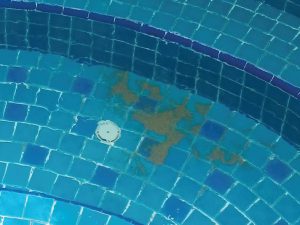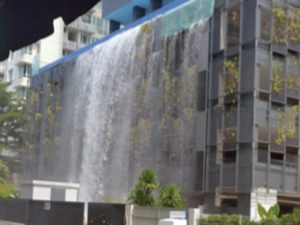Pool Ancillary Services

A defective sand filtration pump where sand accumulates on the pool’s surface

A water recreational area at the roof deck, which has high maintenance and operation costs

A condominium’s infinity pool’s shattered glass panels and the water falling from the fifth floor in consequence — the incident was caused by a blocked drain [1]
DESIGN CONSIDERATIONS FOR POOL ANCILLARY SERVICES
The swimming pool defects shown above could be caused by the design failure of the swimming pool’s ancillary services. All these defects, which are considered environmental and safety hazards, can be prevented — if properly designed, and the requirements set by the mentioned list of standards for the construction and maintenance of swimming pools are adhered to.
Based on the Code of Practice on Environmental Health [2], additional design criteria are specified to address environmental health and safety concerns in the design of swimming pools such as: (a) provision of a water circulation system to facilitate complete circulation of the water through all parts of the pool; (b) provision of overflow weirs for at least 50% of pool’s perimeter (a deck level channel design can be adopted for the overflow weir drainage system for ease of maintenance); (c) provision of at least one standby pump unit and motor to supplement the duty pump provided in the filtration system; (d) installation of flow meters capable of measuring water flows of 1.5 times the designed flow rate on all re-circulation systems; (e) ensuring that the filtration plant adopts rapid sand, diatomaceous earth or any other acceptable filtration system; (f ) provision of sampling taps at the inlet and outlet pipes of the filter; (g) ensuring that the filter backwash water is discharged into the sewer via a backwash water holding tank; (h) supplying the pool with automatic disinfectant and chemical feeders to maintain the bacteriological and chemical characteristics of the water within the water quality limits; (i) ensuring that landscaping materials used have smooth surfaces to facilitate easy cleaning; (j) If a submerged bar is provided in the pool, provision of a sink connected to a sewer must be provided for the installed submerged pool bar; (k) provision of at least two showers around the swimming pool; and (l) provision of adequate ventilation in the case of indoor pools.
Additional guidelines for the design and installation of pool ancillary services and features are highlighted as follows:
• Installation of mechanical ventilation systems for indoor aquatic facilities should be adequate as well as adhere to the provisions of AS 1668.2. (See also SS 553:2016 and BS EN 1886:2007).
• Sufficient lighting should be provided to swimming pools while in use. Ensure that there is no direct interference or reflected glare from lighting sources. Appropriate lighting should also be provided for indoor swimming pools.
• Installation of shade structures for all outdoor swimming facilities is recommended, provided that their location does not obstruct overhead lighting [3].
• All electrical installations should conform to AS 3000 “Wiring Rules”. (Refer also to AS/NZS 3000:2007, AS/NZS 60598.2.18:1998, AS/NZS 3136:2001, BS 7671:2008+A3:2015 and IEC 60335-2-60 Ed 3.1).
• Lightning protection systems should be installed in Group 1 (public access with limited restrictions, such as age without an accompanied adult) and Group 2 (restricted to discrete users and user groups) swimming facilities. They should adhere to the provisions of AS 1768. (See also BS EN 62305-1:2011).
• When installing solar water heating systems, ensure that the construction materials used do not contaminate water, and are not susceptible to corrosion under normal service conditions. The installation of a temperature control system will ensure pool users will not be exposed to water temperatures exceeding 38°C. Solar pool heating systems must be installed on a plumbing circuit that is separate and independent from the filtration system [3].
• An automatic or manual drainage system must be installed to enable the emptying of all the water from system when not in use. The drainage system must incorporate a back-flow prevention valve to prevent water from flowing back into the pool through the filter [3].
• Filtration equipment, outlet devices and skimmer boxes used for pools and spas should be designed and installed by adhering to the provisions in AS 2610.2-2007. (See also BS EN 16713-1:2016 and BS EN 16713-3:2016).
• Plumbing products and fittings for swimming pools and spas should be installed in accordance to the specifications included in AS/NZS 3500.1:2003 and AS/NZS 3500.4:2003. (Refer also to AS/NZS 3500 (Set):2003 and BS EN 16713-2:2016).
• Playground equipment (including water slides) used near or with pools and spas should be designed by complying with the requirements specified in AS 4685. Detailed information on the manufacturing and design for all types of slides is included in AS 4685.3-2004. See also AS/NZS 4422:1996.
• All areas of water slide facilities that are available to the public must also comply with the requirements included in AS 4685.3-2004, AS 2560.2.5-2007 and AS/NZS 60598.2.18:1998. (See also BS EN 13451- 5:2014, BS EN 1069-1 and BS EN 1069-2).
References
[1] The Strait Times (2016). Blocked drain caused condo glass panels to shatter. Retrieved on June 1, 2017 from http://www.straitstimes.com/ singapore/ housing/blocked-draincaused-condo-glass-panels-to-shatter.
[2] National Environment Agency (2005). Code of Practice on Environmental Health. Singapore: National Environment Agency (NEA).
[3] Health and Safety Executive (2003). HSG179: Managing health and safety in swimming pools (3rd ed.). England: HSE Books and Sport England Publications.
Normative References/Standards Referred to for Common Area
• AS 1668.2-2012 — The use of ventilation and airconditioning in buildings — Mechanical ventilation in buildings
• AS 1768 — Lightning Protection
• AS 2560.2.5-2007 — Sports lighting — Specific applications: Swimming pools
• AS 2610.2-2007 — Spa pools — Private spas
• AS 4685.3-2004 — Playground equipment — Particular safety requirements and test methods for slides.
• AS/NZS 3000:2007 — Electrical installations (known as the Australian/New Zealand Wiring Rules).
• AS/NZS 3136:2001 — Approval and test specification — Electrical equipment for spa and swimming pools
• AS/NZS 3500 (Set):2003 — Plumbing and drainage set
• AS/NZS 3500.1:2003 — Plumbing and drainage — Water services
• AS/NZS 3500.4:2003 — Plumbing and drainage — Heated water services
• AS/NZS 4422:1996 — Playground surfacing — Specifications, requirements and test method
• AS/NZS 60598.2.18:1998 — Luminaires Particular requirements — Luminaires for swimming pools and similar applications
• BS 7671:2008+A3:2015 — Requirements for Electrical Installations. IET Wiring Regulations.
• BS EN 1069-1 — Water slides. Part 1. Safety requirements and test methods.
• BS EN 1069-2 — Water slides. Part 2. Instructions.
• BS EN 13451-5:2014 — Swimming pool equipment. Additional specific safety requirements and test methods for lane lines and dividing line
• BS EN 16713-1:2016 — Domestic swimming pools. Water systems. Filtration systems. Requirements and test methods
• BS EN 16713-2:2016 — Domestic swimming pools. Water systems. Circulation systems. Requirements and test methods
• BS EN 16713-3:2016 — Domestic swimming pools. Water systems. Water treatment. Requirements
• BS EN 1886:2007 — Ventilation for buildings. Air handling units. Mechanical performance
• BS EN 62305-1:2011 — Protection against lightning. General principles
• IEC 60335-2-60 Ed 3.1 — Household and similar electrical appliances — Safety — Part 2-60: Particular requirements for whirlpool baths and whirlpool spas
• SS 553:2016 — Code of practice for air-conditioning and mechanical ventilation in buildings